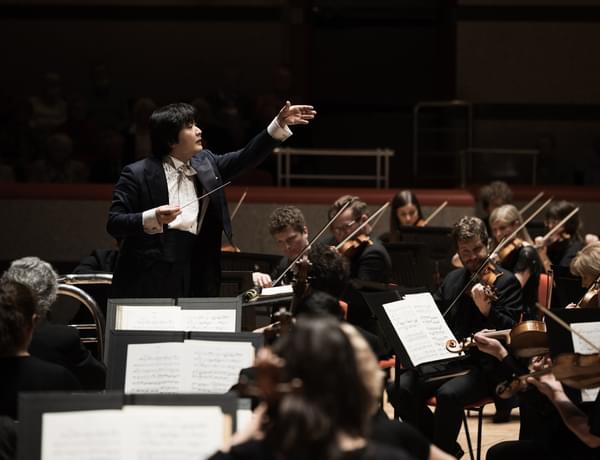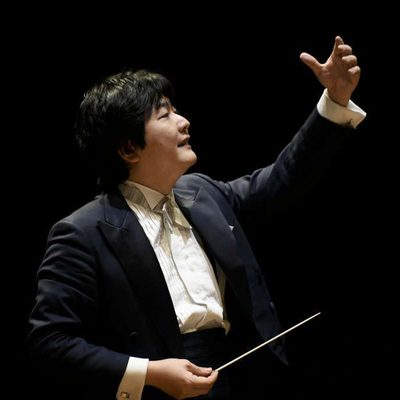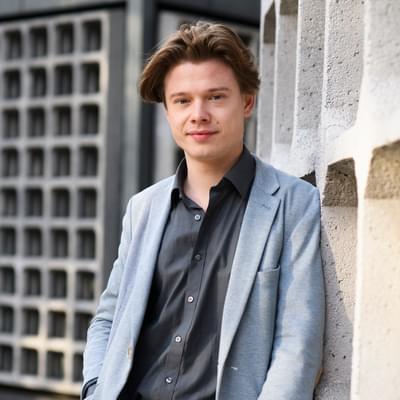Kazuki conducts Respighi & Saint-Saëns

Full programme
- Berlioz, Le Corsaire Overture (9mins)
- Takemitsu, I Hear Water Dreaming (12mins)
- Respighi, Fountains of Rome (19mins)
- Saint-Saëns, Symphony No.3 (Organ) (36mins)
Performers

Kazuki Yamada
Conductor
Sebastian Heindl
Organ
Marie-Christine Zupancic
Flute
Introduction
This will be the very first time that I work with both Kazuki Yamada and the CBSO - I am tremendously looking forward to it!
For me personally, the dedication to Franz Liszt has been the key to understanding the exceptionally beautiful and, in some ways, unusual composition of Camille Saint-Saëns, Organ Symphony.
Franz Liszt was a super-star-piano-virtuoso and composer, as well as one of the most glamorous and controversial personalities in the Romantic nineteenth century Europe. Like the 14-years-older Liszt, the young Saint-Saëns started his career as a child prodigy at the piano in the Salons of Paris. This is where he met his musical idol and a friendship between him and Franz evolved.
Saint-Saëns gave the French premiere of Liszt’s monumental organ composition Fantasy on the Choral “Ad nos ad salutarem undam”, which is itself almost like an “Organ solo Symphony” without orchestra. Liszt and Saint-Saëns were masters in expressing highly Romantic contrasting motives; their pieces for organ express spiritual solemnity and the illustrious ambience of the Paris Salons.
I've played Sain-Saëns’ Third Symphony just once before with a student orchestra in 2021, so it's quite a giant step for me now to be playing it twice with two of the world's most known orchestras - first with the CBSO and just a week later with the Berlin Philharmonic.
The cyclic main theme of the Organ Symphony, presented by the strings in the beginning, to me always sounds like a reminiscence to the apocalyptic choral “Dies Irae”. Through the entire work this pseudo-choral-inspired-theme undergoes a metamorphic catharsis and reappears in the highly solemn Finale elevated by
the otherworldly sound and aura of the pipe organ.
I'm always undecided which moment gives me more goosebumps: the first entrance of the organ in the second movement, which just comes completely surprising and with heavenly quietness, or the beginning of the Finale when the organ joins the orchestra with its full power.
This symphony is both subtle yet powerful Romanticism at its very best! I hope you enjoy the concert.
Sebastian Heindl
Organ
Programme notes
Berlioz dreams of pirates, Takemitsu of water and Respighi of fountains: three brilliant landscapes inspired by poems, paintings and Rome. Saint-Saëns is simply epic in his ‘Organ’ Symphony, its big moment provided by "miracle musician" Sebastian Heindl. The CBSO’s Marie-Christine Zupancic delights in the Takemitsu with its stunning solo for flute.
Overture: Le corsaire
Hector Berlioz (1803-1869)
In the 1840s, Hector Berlioz was often to be found away from Paris, touring Europe or holidaying in the south of France, and the title of his 1844 Overture: Le corsaire travelled almost as much as he did. From initially being Le tour de Nice (he composed it on holiday nearby), it became Le corsair rouge (the translated title of the James Fennimore Cooper novel about pirates) to finally Le corsaire, in reference to Lord Byron’s poem ‘The Corsair’. Berlioz had read Byron feverishly on a previous European trip to Rome in 1830, attracted to the poet’s racy lifestyle, and in the throes of personal heartbreak (during which he planned to murder his sweetheart’s new husband, but that’s a whole other story).
As might be expected after such a narrative build-up, Le corsaire opens with a flurry of great excitement, yet this sparkling introduction lasts only twenty seconds or so. It gives way to a slower passage and a solemnly beautiful melody, yet it soon shifts into unsettling musical territory. The bustle of the beginning returns, and the pace rarely flags from then on. The opening theme, as well as a complex version of the slow passage, rub along boisterously until the close. As Berlioz scholar David Cairns has put it, ‘the effect is of an upheaval of sea and sky, the musical equivalent of a Turner storm at sea.’
I Hear the Water Dreaming
Tōru Takemitsu (1930-1996)
Takemitsu’s output embraces a huge range of styles and influences, ranging from electronics, to the sounds of his home country of Japan, to twentieth century French music, to Aboriginal Art. The imagery and sonic associations of water were also of particular significance to him (his 1960 work Water Music, for example, was based entirely on recordings of water droplets). I Hear the Water Dreaming, composed in 1987, was inspired by a painting by an artist from the Papunya region of Western Australia. The concept of ‘Water Dreaming’ belongs to the tradition of ‘Dreamtime,’ beliefs and stories held by Aboriginal tribes; many of these stories, in regions where water is scarce, concern the summoning of or locating sources of water. The wistful, delicately poised atmosphere of Takemitsu’s orchestral piece – which also channels the sensuous textures and gently shifting rhythms of such French composers as Olivier Messiaen – suggests both the preciousness and vulnerability of the ‘water dream’. Imagery and musical figures are conceived as essentially the same by the composer, who wrote of the opening flute melody that it was ‘a musical adaptation of the water icon in the painting.’ He went on to add that the rest of the material derived from this opening theme both in terms of melody, and – presumably – in terms of the lightness of the orchestration: there is no brass or other ‘grounding’ instruments. The music, like water, flows unimpeded.
Fountains of Rome
Ottorino Respighi (1879-1936)
This is one of the Italian composer Respighi’s most famous piece, and the one which ultimately propelled him into success, of a popular as well as financial kind. It depicts four fountains in Rome at four different times of day, and was initially inspired by a stay near the Valle Giulia where Respighi noticed the perpetual background murmur of a fountain. The first and last movements – dawn and sunset respectively – are contemplative in nature, while the middle two are colourful, suggestive of the constant gushing of fountain spray. ‘Dawn at the Valle Giulia’ has an appropriate quality of waking up, with rippling strings under beguiling wind melodies, taking a while to settle into solidity. The oboe has a starring role, initially playing what the composer described as a ‘bucolic’ theme, and later doubling with a solo cello; while the celeste provides an atmospheric series of chords, suggestive of gentle water droplets.
The second movement ushers in an entirely different character: horn fanfares and brilliantly effervescent textures across the whole ensemble. It depicts a morning at the Triton fountain: the exuberance of the entire orchestra suggests the sparkling of the fountain jets against brilliant sunshine. After a quiet conclusion, we visit the Trevi fountain at noon, a movement of even more irrepressible spirits. It is dominated by a noble, rising theme – somewhat operatic in character, and exceeding the modest bounds of a fountain in its imagery. As Respighi put it, the movement depicts ‘Neptune’s chariot drawn by sea-horses, and followed by a train of sirens and tritons.’ Finally, Respighi noted, we arrive in the ‘nostalgic hour of sunset’, with tolling bells and a more sultry atmosphere. The woodwind once again comes to the fore, periodically joined by a solo violin, and against a backdrop of shimmering strings. The bells lead the music to the conclusion, and to the close of this remarkable day in Rome’s fountains.
Organ Symphony
Camille Saint-Saëns (1835-1921)
Camille Saint-Saëns was not known for his jaunty, effervescent character – he was often prickly, rude and even downright offensive – yet much of his music is buoyant, charming, and full of a bracing optimism. His Symphony no 3 (1886), commonly known as the ‘Organ Symphony’, tracks a course from stormy opening to triumphant conclusion in a radiant C major. It is perhaps no coincidence that he was composing his ever-popular Carnival des Animaux at the same time: its playful atmosphere and creative approach to instrumentation can be heard across the whole Symphony.
The composer was a proud Frenchman, keen to establish a national ‘musique’, and had founded the Société Nationale de Musique with the aim of promoting the music of contemporary French composers. The Symphony’s ‘Frenchness’ can be strongly felt in its elegant melodies and the clarity of the orchestral texture, and in its distinctive use of the organ. Saint-Saëns himself was a well-known organist; on hearing him play, the Hungarian composer Liszt had declared him the best organist in the world (perhaps as a result of this Saint-Saëns dedicated the Symphony to Liszt). Including the organ in a Symphony was an unconventional touch (there is also a part for piano) and the composer was aware it might limit performance possibilities. But, characteristic of Saint-Saëns’ music generally, it both honours tradition and provides a fresh perspective to a classical form.
The Symphony is in two movements, each in two contrasting sections. The organist has to wait a while for the big moment, which comes at the start of the final section (though there is an appearance in the Adagio, gently augmenting the orchestral texture). The Symphony starts in a dark place: a hushed opening and agitated first section, which includes the ominous ‘Dies Irae’, or ‘day of wrath’, theme (originally from the plainchant mass for the dead) on the trombones. The substantial Adagio section is warmly lyrical, and for the most part sumptuous and lush, with only a brief moment of disquiet introduced by plucked strings and a hint of the ‘Dies Irae’. The second movement brings back the turbulent atmosphere of the opening, and welcomes the piano – at times requiring an extra player – for some virtuosic capering up and down the keyboard. The triangle and cymbal are then brought to the fore, bringing with them a more festive atmosphere. The organist takes the spotlight in a big way at the start of the concluding section with a gigantic C major chord. With some energetic support from the pianist(s), the organ part gathers in prominence, eventually soaring over the often huge orchestral sound and bringing the work to a joyful conclusion.
© Lucy Walker
Featured image © Benjamin Ealovega